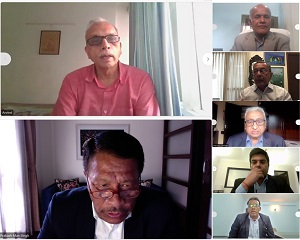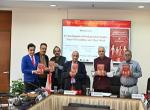On the 23rd of March, the Vivekananda International Foundation organized a virtual book discussion on “India’s Economic Miracle and Nepal”. The session began with a series of introductory remarks by Mr. Prakash Man Singh, Member of Parliament and Senior Leader of Nepali Congress, and Professor Hari Bansh Jha, author and executive director Center for Economic and Technical Studies, Nepal. These remarks were then followed by comments on the nature of India-Nepal relations by Ambassador Deep Kumar Upadhyay, Ambassador Ranji Rae, Mr. Atul K Thakur and Mr. Ganesh Kumar Mandal. Alongside raising the importance of a shared economic growth between India and Nepal, the discussion also presented current shortcomings and potential avenues in bilateral cooperation.
Mr. Prakash Man Singh began by outlining the significance of India’s economic growth. While mapping India’s journey from liberalization in the 1990s to its current emergence as an economic power, he drew attention to the profound leaps in India's economic gains. Mr. Singh also detailed India’s miraculous transformation into the highest producer of food grains, dairy and IT software. At the same time, he referenced the relative stability of the Indian economy when ‘Asian Tigers’ and the United States succumbed to the global recession of 2008. Moreover, Mr. Singh commended Indian extension of aid and assistance to its immediate neighbourhood and countries like Britain.
Mr. Singh then proceeded to highlight Nepal’s historic socio-cultural, religious, political and economic ties with India. From both countries’ leaders seeking refuge in the other state to the present open-border system, he drew upon the unrestricted movement of citizens and ideas between both regions. Mr. Singh also credited India’s multi sector investment in Nepal, including the development of roads, telecommunications, cross border electric lines and hydropower. As an avenue for prospective cooperation, he stressed the importance of Nepal sharing the fruits of India’s economic miracle via the institution of relevant infrastructure.
Post Mr. Singh’s remarks, Professor Hari Bansh Jha took to explaining the intricacies of India’s economic boom. He commenced by describing the rampant illiteracy, poverty, limited healthcare and poor agricultural infrastructure that followed Indian independence in 1947. Professor Jha also shed light on India’s inability to feed its population and its negative, ‘snake charmer’ international image. He then outlined the Indian government’s course of action in 1951: modernization and the adoption of a free market economy with dominant socialist elements. These decisions, however, isolated the Indian economy, proliferated state-control and failed to remedy the declining growth rate. Professor Jha then highlighted the fiscal deficit that followed suit in 1990- forcing India to seek the assistance of the IMF in an attempt to manage its balance of payments crisis.
Professor Jha continued by applauding the economic reforms instituted by then Prime Minister, P.V. Narasimha Rao, in 1991. He commended the immediate effectiveness of India’s reforms, which translated into an increased savings rate, investment rate and economic growth rate. He then shared the alteration in India’s global image: it was now a fast-growing economic charmer, attracting widespread foreign direct investment.
Professor Jha also shared a range of complementary factors that aided India’s development. Firstly, he laid emphasis on India’s demographic dividend and its growing workforce that would eventually surpass the strength of China’s labor-pool. He then described the changing status of Dalits, the emerging role of Dalit entrepreneurs and their distaste in reservations. Additionally, he also mapped the development of India’s five ‘rogue’ states and their individual attempts at fostering foreign investment- instead of relegating responsibility to the central government. Professor Jha then outlined the changing phase of India’s new economy: an emphasis on the manufacturing sector, defense procurement, telecommunications and power.
When shifting his comments towards the nature of Nepal-India ties, Professor Jha tracked the history and prospects of bilateral cooperation. He noted the importance of Indian investment in Nepal: its share in Nepal’s total exports is eighty-five percent and its share in Nepal’s total imports is sixty-five percent. At the same time, however, he marked a decline in Indian investment over the past twelve years. Professor Jha then shed light on the India-based Nepalese workers sending remittances back home, on the Gurkha soldiers receiving pensions from India and on the Indian tourists visiting Nepal and supporting local Nepalese economies.
When highlighting the avenues of future cooperation, Professor Jha stated that Nepal was fortunate to have India as a neighbour and complemented both state’s mutually beneficial relationship. His first recommendation centered on Nepal taking advantage of its Indian border states: Bihar, Uttarakhand, Uttar Pradesh, West Bengal and Sikkim. He acknowledged that these regions’ population accounts for one third of the total Indian population and stressed the opportunity for Nepalese producers to sell their goods here. Secondly, since India might be moving away from more labour-intensive means of production, he strongly recommended Nepal to fill the boat and secure India as a subsidiary market. Moreover, he also shared that a ‘trickling-down’ of economic benefits from India to Nepal is not an automatic phenomenon- it is, in fact, crucial to establish transit networks between both countries to allow for seamless engagement and trade. Finally, he underscored the importance of political will in facilitating these developments.
After having made his comments, Professor Jha passed the mike to Ambassador Deep Kumar Upadhyaya, former Nepalese ambassador to India. Ambassador Upadhyaya began by reinforcing the dutiful and unique essence of eastern philosophy that ties India and Nepal across a multitude of aspects. He claimed that India’s economic miracle is an inspiration to Nepal. In particular, he highlighted Nepal's necessity to improve its budget consumption and emulate Indian capacities of completing a certain task in a stipulated time frame and within a set budget. Moreover, Ambassador Upadhyaya also dwelled upon the importance of Indian engagement with Nepal. Given the agreeable terrain shared by both countries, he stressed the development of trans-border connectivity facilities. In addition, he noted that Nepal would only be able to overcome its trade deficit if India guaranteed it a market for its agricultural produce. While referencing the BIMSTEC and a shared transit facility for electric transmission with Bangladesh, he mentioned that although developing bilateral policies is important, their quick and efficient implementation is even more vital to the development of Nepal. For his closing remarks, Ambassador Upadhyaya urged both countries to identify solutions over border disputes and multipurpose water management. The development of a solution, per him, would create a win-win situation for both countries.
Mr. Ganesh Kumar Mandal then followed up on Ambassador Upadhyaya’s remarks by re-referencing India and Nepal’s historical ties. He also recommended that India extend its ‘Make in India’ projects to Nepal as well. According to Mr. Mandal, this would be an excellent way to eliminate poverty in Nepal.
After Mr. Mandal, Mr. Atul K Thankur shared his remarks. To begin, he underlined that Nepal’s time for economic development had come and that all relevant Nepalese stakeholders had to learn from India’s economic miracle and attempt to emulate it. He mentioned that Nepal would have to improve the formalization of its industry and the nature of economies of scale in its territory. He also stressed that despite multiple elections and leaders with dissimilar political beliefs or practices, India’s development goals were largely left untouched by personal convictions. This, for Mr. Thakur, is an aspect that Nepal must adopt. He also underscored the importance of sub-regional cooperation between both countries. Additionally, while referencing hydro-electricity, he recommended that Nepal develop a much more price competitive strategy to sustain itself in Indian markets. Finally, he concluded by outlining the urgency of instituting a ‘Make in Nepal’ programme since the country is experiencing considerable supply constraints.
Finally, Ambassador Ranjit Rae, former Indian Ambassador to Nepal, took the floor. He began by stating that Nepal’s economic prosperity, stability and development is completely in India’s interests. According to him, India would only develop when its immediate neighbourhood was at peace and prospering. Moreover, he emphasized the importance of placing the India-Nepal economic relationship in a sub-regional context. He posited that India needed to develop the vision for and create a common, interconnected and interdependent economic space with Nepal- wherein both countries could trade and invest without let. This would help resolve any bilateral political issues via the creation of a web of relationships through connectivity: road, rail, digital, energy. Additionally, he outlined the plan for developing joint and even tri-lateral projects with India, Nepal and their neighbours. Forging these linkages would cement the route towards a stable and prosperous region. At the same time, he believed that institutions like the Chamber of Commerce should urgently investigate the reasons for and solutions to flailing Indian investment in Nepal. Post having shared a series of avenues for India-Nepal engagement, Ambassador Rae also put forth some recommendations to the Nepalese economy. Firstly, he stated that instead of solely searching for foreign direct investment, Nepal should focus on generating a bulk of its savings and investments internally. He also suggested that Nepal improve its capacity to ‘absorb’ its budget.
Towards the end of the discussion, Professor Jha and Dr Arvind Gupta spoke about three ways to ensure that India’s economic miracle trickle into Nepal: develop political determination on both sides, institute adequate infrastructure and maintain political stability on the Nepalese side.







Post new comment